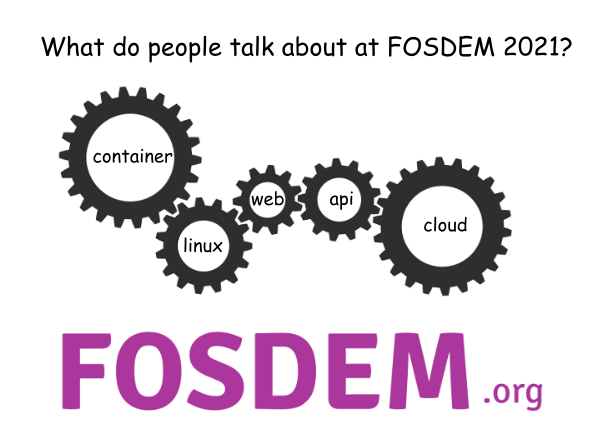What do people talk about at FOSDEM 2021
FOSDEM is the Free and Open Source Software Developers European Meeting.

Introduction
What is FOSDEM?
FOSDEM is a non-commercial, volunteer-organized event centered on free and open-source software development (with a geographic focus on the European open source ecosystems / projects). FOSDEM is aimed at developers and anyone interested in the free and open-source software movement. It aims to enable developers to meet and to promote the awareness and use of free and open-source software.
FOSDEM is held annually since 2001, usually during the first weekend of February, at the Université Libre de Bruxelles Solbosch campus in the southeast of Brussels, Belgium. The history of FOSDEM is neatly available at Wikipedia, while the current conference (2021) website is available here. FOSDEM is a large event (2 days, 8K+ participants, 800+ talks) which makes it a reasonable snapshot of the current state of the open source universe. The schedule of all 2021 talks (including abstracts) is available here. You will probably not be surprised that in 2021, the event will be entirely online.
What are people talking about at FOSDEM?
Continuing with a tradition we started last year we will attempt to get a glimpse at what the open source community is up to those days (or at least what they want to talk about!
Data and Methodology
To get an overview of what topics are “cross-cutting” (affecting multiple projects) at FOSDEM we will use the talk abstracts:
- The data set consists of the 710 talk descriptions (Available at the above linked xml file).
- The text of each talk description is pre-processed using NLTK to extract the unique keywords used within each talk.
- Once this filtering is done, we look at the frequency with which unique keywords occur across multiple talks.
- Each keyword is thus assigned a frequency of occurrence across the conference. This controls for any speaker being particularly fond and loquacious in their use of a particular keyword in any particular abstract / description!
- To avoid spurious accuracy the frequency is rounded to no decimal digits.
The distribution of keywords has a very long tail nature. This reflects the vast universe of projects and interests of the open source community. This translates into most of the thousands of unique keywords receiving less that 1% mention.
So, what are people talking about at FOSDEM 2021?
Here are the main statistics about various concrete technologies or patterns mentioned (next to the 2020 result). The filtering of what to include among the many thousands of keywords is somewhat subjective (e.g. should we include the term interface if we include the term API?).
| Keyword | 2020 Frequency | 2021 Frequency |
|---|---|---|
| linux | 12% | 8% |
| web | 10% | 8% |
| cloud | 10% | 7% |
| container | 7% | 6% |
| api | 13% | 6% |
| python | 6% | 6% |
| kubernetes | 6% | 5% |
| java | 4% | 4% |
| mariadb | - | 4% |
| mysql | 2% | 3% |
| postgres | - | 3% |
| github | 3% | 3% |
| docker | 2% | 3% |
| kotlin | - | 2% |
| libreoffice | 2% | 2% |
| gnu | 2% | 2% |
| 4% | 2% | |
| pandemic | - | 2% |
| javascript | 3% | 2% |
| git | 2% | 2% |
| apache | 2% | 2% |
| enclave | - | 2% |
| rust | 3% | - |
| intel | 2% | - |
| mozilla | 2% | - |
Overall we see quite a lot of stability: on the timescale of one year, the same keywords/topics seem to preoccupy the community, which is not surprising given the long term investment and development roadmap of open source projects. (The unfortunate exception this year is the pandemic keyword)
Beyond the big picture, there is noticeably more dispersion this year (less concentration / focus on some topics). This means less “hype” if you will. E.g. the API keyword retreated from a 13% mention rate to 6%.
Maybe a notable remark: There seems to be an increase of interest in open source relational databases, with mariadb, mysql and postgres all significantly exceeding the 1% threshold (which they did not cross last year).
On the language front python, java, javascript pretty stable, kotlin has increased while rust has decreased.
Disclaimers
Well, there are many disclaimers, but this blog post is meant to highlight the vibrancy and fun of the open source world, not an article to be published in an esteemed Journal of Open Sourceology. So we leave it at that!
Comment
If you want to comment on this post you can do so on Reddit or alternatively at the Open Risk Commons. Please note that you will need a Reddit or Open Risk Commons account respectively to be able to comment!